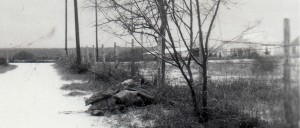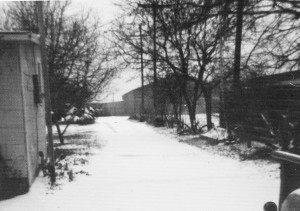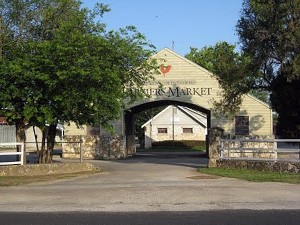Although the sign at the Burnet Lane entrance once read “Austin’s Historic Farmers’ Market,” the stone-and-metal buildings originally at 6701 Burnet Road were never officially designated historic. The land they were built on, though, has some historic Central Austin roots that date back to the Texas Revolution.
 For 25 years, the market was often a popular gathering place for neighbors who visited its produce stands, craft booths, restaurants, and special events. Beginning in 2015, the rustic buildings and the large red barn south of them were replaced by the five-story, mixed-use Burnet Marketplace development.
For 25 years, the market was often a popular gathering place for neighbors who visited its produce stands, craft booths, restaurants, and special events. Beginning in 2015, the rustic buildings and the large red barn south of them were replaced by the five-story, mixed-use Burnet Marketplace development.
(The 1947 photo, above, looks west from across Burnet Lane and shows the original stone buildings that were later part of the farmers’ market. The 1973 photo, below, shows the red barn built later. Both were taken from the long driveway of the Frank Pease farm on the east side of today’s Burnet Lane. Pease purchased the farm in 1936, and he and his family lived there until the 1970s.)
 The farmers’ market property was part of a more than 3000-acre land grant to George Washington Davis. He received it for his service in the decisive Battle of San Jacinto during the Texas Revolution.
The farmers’ market property was part of a more than 3000-acre land grant to George Washington Davis. He received it for his service in the decisive Battle of San Jacinto during the Texas Revolution.
The stonework on the buildings (but not the later fence or Burnet Lane entrance) was similar to the style of Frank B. Wright (born Benjamin Franklin Wright), a skilled local builder and stonemason in the Brentwood, Allandale, and Rosedale neighborhoods in the 1940s and 1950s. (See photos of the old farmer’s market buildings on pages 4 and 5 of the City of Austin Historic Landmark Commission report about the property. Note: The Alfred G. Prinz family did not live at this location between 1947 and 1955, as stated in the HLC report. According to the Austin City Directory, the Prinz family lived nearby in the Brentwood neighborhood.
The Davis land also included part of the Allandale neighborhood west of Crestview and Brentwood. The George W. Davis Family Cemetery, near the corner of Vine and Twin Oaks in Allandale, was named a Historic Texas Cemetery in 2000. Limestone on the Davis property near Shoal Creek was quarried in 1853 for the second State Capitol. In the early 1950s, 30 acres of Davis’s original land became Northwest Park.
The farmers’ market site was among 162 acres purchased by W. P. Allen in 1921, after Davis and his widow, Elvira, passed away, and it was the four acres sold by Allen to Travis County in 1941. Wilbur P. Allen was a prominent Austin lawyer and rancher; he also owned La Josefina Ranch in Jim Hogg County, Texas. Allen Park, a small city park west of Balcones Drive in Austin, is named for him.
 When Travis County owned the four-acre property, from 1941 to 2007, it was mostly used as a maintenance facility. In 1947, Burnet Lane (looking north from the Pease farm in the photo, right – click on photo to enlarge) was part of the original Upper Georgetown Road—today’s Burnet Road. Sometime in the 1940s, after World War II, a new section of the road was built on the west side of the county site to help straighten the road through that area.
When Travis County owned the four-acre property, from 1941 to 2007, it was mostly used as a maintenance facility. In 1947, Burnet Lane (looking north from the Pease farm in the photo, right – click on photo to enlarge) was part of the original Upper Georgetown Road—today’s Burnet Road. Sometime in the 1940s, after World War II, a new section of the road was built on the west side of the county site to help straighten the road through that area.
In the late 1980s, the county leased the property to Hill Rylander, and it became the Travis County Farmers’ Market, according to the original 1989 sign along Burnet Lane. In 2007, the county decided it was time to sell. On March 21, 2007, three prospective buyers presented their ideas to county commissioners and neighbors—Southwest Strategies Group, developer of Seaholm and Penn Field; Colina West, developer of the San Jose Hotel on South Congress; and Paz Paramdeep Dhody, a businessman known for his collection of large crystals. The county accepted Dhody’s offer, and he became the new owner.
Four years later, the site reopened as the 6701 Burnet Road Market and was managed by Jean (J) Kruse. At some point the 1980s sign was repainted to read “Austin’s Historic Farmers’ Market” (as in the photo, below, looking west from Burnet Lane). The Violet Crown Festival, originally in Brentwood Park, was held at the market in May 2011. In 2012, the event moved back to Brentwood Park.
 When Dhody decided to sell the property in 2012, the City of Austin Historic Landmark Commission researched the property to see if it could be considered historic. At the July 30, 2012, meeting of the commission, city staff recommended a release of the demolition permit, rather than a historic designation. Paz Dhody, J Kruse, and five others appeared in support of the demolition. No one appeared in opposition.
When Dhody decided to sell the property in 2012, the City of Austin Historic Landmark Commission researched the property to see if it could be considered historic. At the July 30, 2012, meeting of the commission, city staff recommended a release of the demolition permit, rather than a historic designation. Paz Dhody, J Kruse, and five others appeared in support of the demolition. No one appeared in opposition.
Before the market closed in April 2014 and the original buildings demolished, The Weird Sisters Women’s Theater Collective presented “Brides of the Moon” in the red barn just south of the farmers’ market in June 2013. Alyson Curtis, a member of the group, remembers that when they presented their play the barn was full of large crystals, likely among the ones owned by Paz Dhody.
The developers of the new Marq on Burnet incorporated some of the crystals into the construction and preserved a large tree in the northwest corner of the property near the Pour House, which reopened in Summer 2016. Because of the COVID-19 pandemic, the Pour House closed in June 2020. The JewBoy Sub Shop opened in the space in March 2021.
Special thanks to Crestview neighbor Mickey Pease Bauer for sharing her family’s 1947 photos of the stone buildings and 1973 photo of the red barn, and to Allandale neighbor Steven Zettner for sharing his 2014 photo of the “Austin’s Historic Farmers’ Market” sign.
Copyright 2016-2021 Susan Burneson. All rights reserved.
